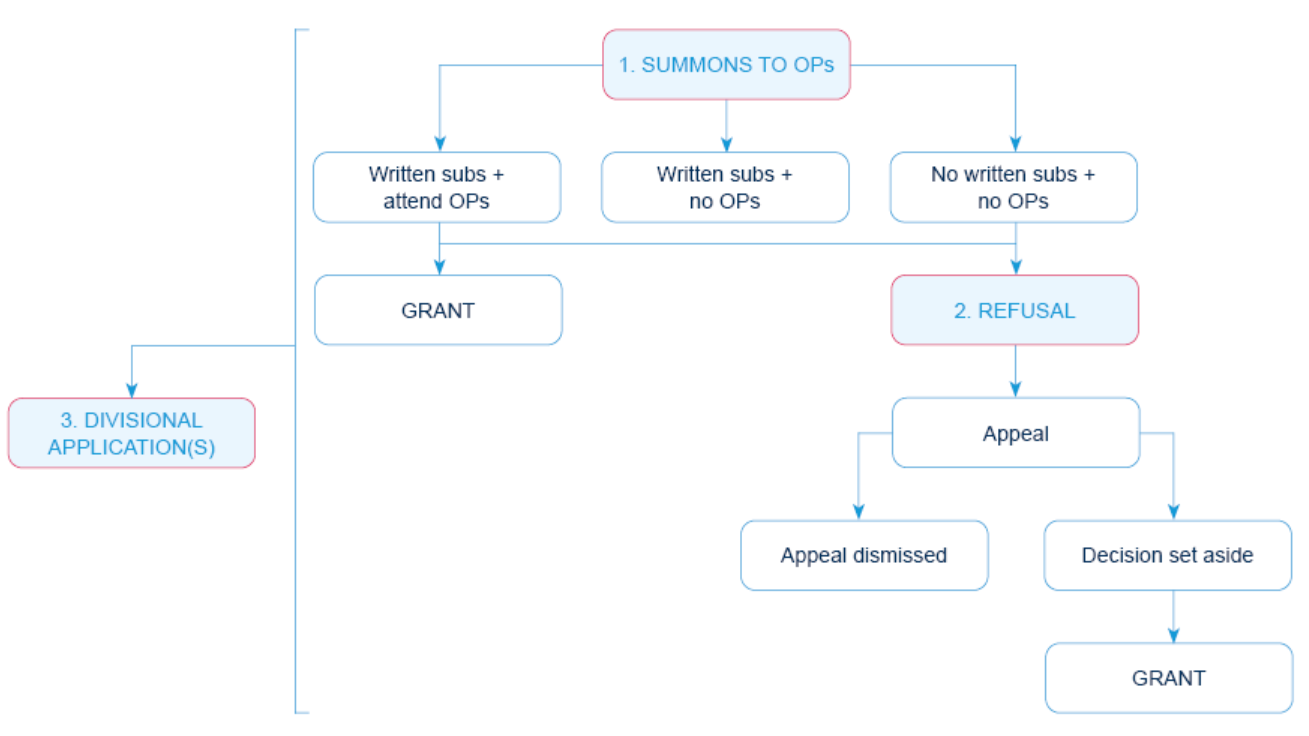Oral proceedings, appeals and divisional applications: options for tricky cases at the EPO
We have all experienced tricky cases at the European Patent Office (EPO). Sometimes, it seems the examiner simply cannot be convinced about the patentability of a particular invention. After several rounds of written correspondence, the dreaded “summons to oral proceedings” is therefore received. It can then be difficult to decide on the best strategy. Should you attend the oral proceedings to plead your case? Would it be better to simply allow the examiner to refuse the application and then file an appeal? Or would filing a divisional application be most appropriate? This article explores some of the options.
EPO examination procedure
A simplified version of the EPO examination and appeals procedure after an applicant (or appellant) receives the summons to oral proceedings (OPs) is shown in the flow chart. We will discuss the parts of the procedure indicated 1-3.

1. Summons to oral proceedings
A summons is issued upon request if the examiner intends to refuse the patent application. This typically happens after one or more written examination reports have been issued (although, in exceptional circumstances, a summons may be issued as the first examination report). The summons schedules the oral proceedings and provides the opportunity to file written submissions (together with one or more claim “requests”) in advance of them taking place. A written explanation of the outstanding objections is provided with the summons. Options in response to the summons include options A, B and C.
Option A - don’t provide written submissions or attend the oral proceedings
Option A may be appropriate if, for example, the examiner’s objections seem well founded and the case is of limited commercial importance. Occasionally, option A may also be appropriate if you disagree with the examiner’s objections to such an extent that further engagement with the examiner is unlikely to be fruitful (for instance, if the examiner repeatedly refuses to search claims directed to a computer-implemented invention due to an alleged “lack of technical effect”). Option A will very likely result in refusal of the application.
Option B - provide written submissions but don’t attend the oral proceedings
Option B may be appropriate if, for example, there are still written arguments and/or amendments you have not put forward which might persuade the examiner but the case is not of sufficient commercial importance to justify the work of attending oral proceedings. If the examiner is convinced by the written submissions, the case will be granted. Otherwise, the case will be refused.
Option C - provide written submissions and attend the oral proceedings
Option C may be appropriate if, for example, the application is of sufficient commercial importance to justify the work of attending oral proceedings. Even if the examiner’s view of the case is negative, filing written submissions (together with all claim “requests” you wish the examiner to consider) in due time and attending the oral proceedings is important because it allows all admissible arguments (both written and oral) and/or amendments to be discussed at the oral proceedings. This means they should be admissible in an appeal if the case is refused (see below).
Each claim request includes a set of claims which the examiner is asked to consider. Claim requests are usually prioritised (with a “main” request and one or more “auxiliary” requests). It is strongly advisable to file all desired requests with the written submissions in advance of the oral proceedings (whether or not you plan to attend the oral proceedings) to ensure their admittance into the examination proceedings (and therefore being subject of any appeal).
If the examiner believes one of the filed requests overcomes the outstanding objections, they may make contact before the oral proceedings to try to allow the case without holding the oral proceedings.
Many examiners are also happy to, on request, give a further preliminary opinion on the case after the written submissions have been filed but before the oral proceedings in order to allow an informed decision about attendance at the oral proceedings to be made. Thus, if the examiner continues to have a negative view of all requests and the case is of limited commercial importance, you may now decide not to attend the oral proceedings. On the other hand, if the case is of high commercial importance and/or you think the examiner’s objections remain unfounded, the preliminary opinion should indicate the main outstanding issues to help prepare for the oral proceedings.
Filing written submissions and seeing the reaction from the examiner may thus help in deciding between options B and C.
2. Refusal
If the examiner can be convinced that the claims are allowable, the application proceeds to grant. Otherwise, the application will be refused. Refusal marks the end of examination proceedings. If an appeal is filed in due time (a notice of appeal being due within two months of notification of the written decision to refuse), the application enters appeal proceedings.
The benefit of an appeal is that the EPO’s Board of Appeal is completely separate to the EPO’s Examining Division. An appeal therefore allows a completely new set of eyes to review the case.
However, an appeal is not a re-examination of the case. Rather, it is an assessment of whether the Examining Division’s decision to refuse the case was legally correct. An appeal must therefore be based on the requests, facts, objections, arguments and evidence previously put forward during examination. Admission of any new requests, for example, is therefore at the discretion of the Board of Appeal.
The bar for admissibility of new requests is high. Typically, the admissibility of a new request must be justified by the appellant (for example, by demonstrating that a new objection not previously raised during examination has been raised by the Board of Appeal). The new request must also, prima facie, overcome any outstanding issues and must not give rise to any new objections.
For commercially important cases, it is therefore generally advisable to file written submissions (together with all claim requests) and attend the oral proceedings before the Examining Division (that is, option C), if budget allows. Doing this ensures that all admissible requests and arguments which might be relied on at appeal are submitted during examination and therefore should be admitted at appeal. For this reason, it is also important to give your patent attorney authorisation to amend the application during the oral proceedings within certain bounds so they can address any new objections the Examining Division may raise.
Appeal proceedings end with either the appeal being dismissed (in which case, the original decision to refuse stands) or the decision to refuse being set aside. If the decision to refuse is set aside and the Board of Appeal concludes the claims are allowable, the application will be allowed. The Board of Appeal will then remit the application (with the allowable claims) back to the Examining Division to continue the granting process.
3. Divisional application(s)
In some other jurisdictions, “continuation” applications (or similar) may be used to try to progress a case repeatedly rejected by an examiner. Unfortunately, trying to use divisional applications at the EPO to similar effect is often not a successful strategy.
This is because a divisional application is likely to be examined by the same examiner as the parent application. If the examiner intends to refuse the parent application, they will therefore also likely look to refuse the divisional application if its claims (which must comply with the EPO’s strict added subject-matter requirements with respect to the parent application as originally filed) contain similar subject matter.
Of course, there are other good reasons for filing a divisional application. For example, a divisional may be required to pursue protection for embodiments removed from the scope of the parent claims to overcome a lack of unity objection. A divisional may also be filed to try to obtain a broader claim scope if the claim scope of the parent is narrowed early during examination to try to obtain a swift grant. It may also be desirable to file a divisional if, for example, examination of the parent case is ending but there is still commercial value in maintaining a pending patent application.
Key takeaways
For tricky cases at the EPO, it is common to receive a summons to oral proceedings. How to deal with this often depends on the commercial importance of the case. For commercially important cases, filing written submissions (and all claim requests) in advance of the oral proceedings, maintaining contact with the examiner and, if necessary, attending the oral proceedings is usually the best strategy. The case will then either be granted or, at least, should be in a good state for appeal proceedings. Divisional applications are unlikely to be a good alternative to oral proceedings for obtaining allowance of a case. However, there may be other good reasons for filing a divisional application.
For advice on the best strategy for a specific case, please contact your usual D Young & Co advisor.
